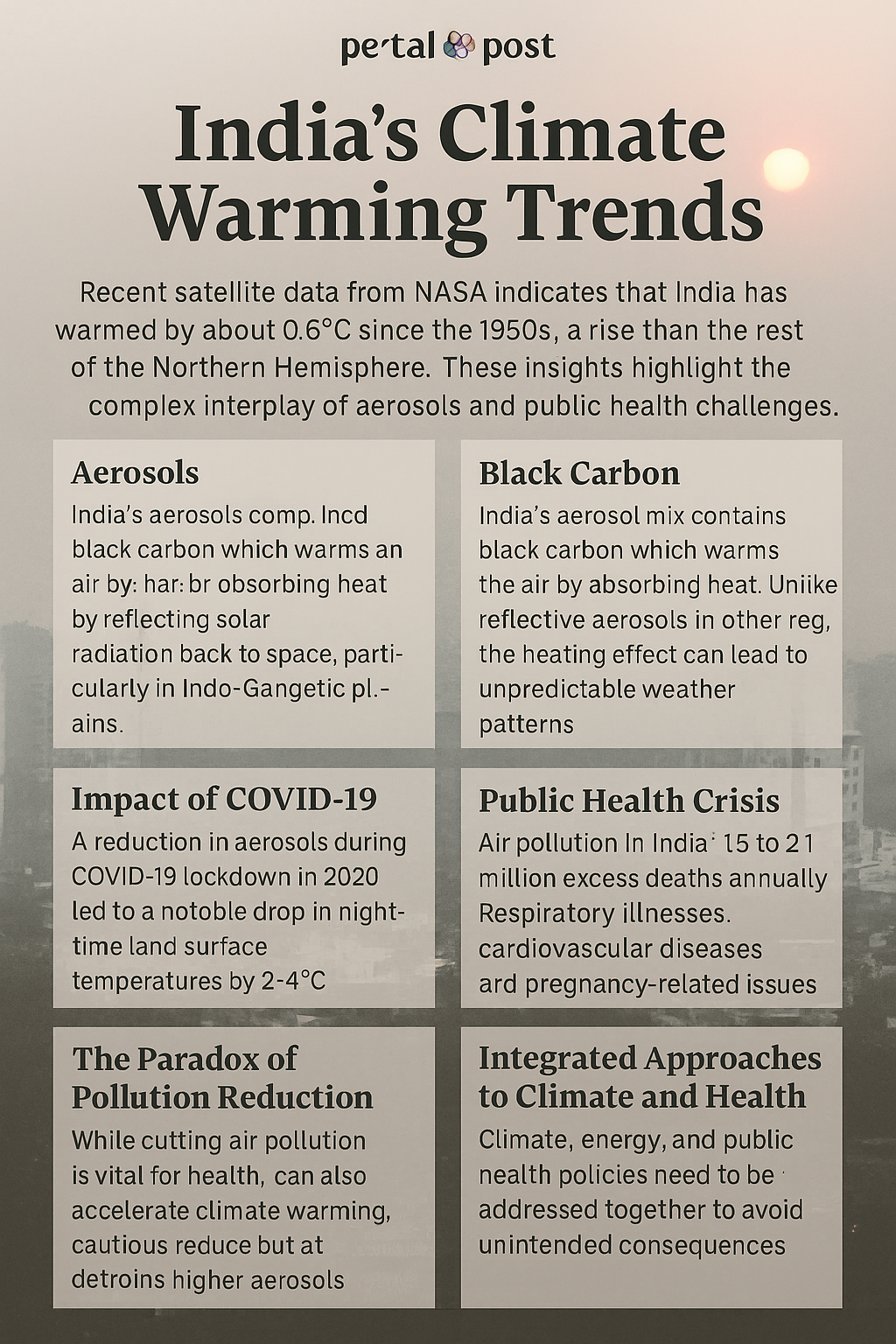
📅 May 3, 2025, Post 6: India’s Climate Warming Trends: The Cooling Illusion & the Hidden Heat |Mains Essay Attached | Target IAS-26 MCQs Attached: A complete Package, Dear Aspirants!
India’s Climate Warming Trends: The Cooling Illusion & the Hidden Heat

INTERNATIONAL HERO — PETAL 006
📅 May 3, 2025
🌍 Thematic Focus
Climate Change | Public Health | Atmospheric Science
🌤️ Intro Whisper
While the world warms steadily, India’s skies tell a more complex story—of clouds that cool and particles that poison.
🔍 Key Highlights
- Warming Trends: India has warmed by 0.6°C since the 1950s, which is lower than the average for the Northern Hemisphere, as per recent NASA satellite data.
- Role of Aerosols: Fine particulate matter, especially in the Indo-Gangetic plains, reflects sunlight back into space, slowing surface warming.
- Black Carbon Puzzle: India’s aerosol mix includes black carbon, which absorbs heat, unlike cooling sulphates in other regions—intensifying local warming while reducing cloud reflectivity.
- COVID-19 Lockdown Insight: A sharp drop in aerosol levels during 2020 led to 2–4°C lower night-time land surface temperatures, revealing the cooling power of atmospheric pollution.
- Public Health Toll: Air pollution causes 1.5 to 2.1 million premature deaths yearly in India—through respiratory diseases, heart conditions, and pregnancy complications.
- The Paradox: Reducing air pollution may reduce cooling aerosols, thereby exposing India to sharper temperature rises, especially due to higher ground-level ozone in hotter months.
📘 GS Paper Mapping
GS Paper 1: Geography (Climatic Changes)
GS Paper 2: Health & Governance
GS Paper 3: Environment & Pollution
✍️ Relevant Essay Attached
“When Pollution Becomes a Paradox: India’s Warming in a Cooling Sky”
📎 [Essay included below in the same post.]
💡 A Thought Spark — by IAS Monk
“It is not the fire that burns first, but the wind that feeds it.”
High Quality Mains Essay For Practice :
Word Limit 1000-1200
When Pollution Becomes a Paradox: India’s Warming in a Cooling Sky
🟫 Word Count: ~1100 words
📌 Topic: India’s Climate Trends, Aerosols, and the Public Health–Climate Paradox
Introduction
India stands at the crossroads of an environmental riddle. While most of the Northern Hemisphere experiences accelerated warming, India’s land has warmed by only about 0.6°C since the 1950s. This seemingly modest rise hides a complex interplay of pollutants and climate forces, particularly aerosols, that simultaneously shield and harm the population. The latest NASA satellite data reaffirms this paradox—India’s skies are filled with particles that cool the Earth’s surface while contributing to one of the world’s most severe public health crises. As the country attempts to combat pollution, it must brace for the unintended climatic consequences of success.
Aerosols: The Cooling Cloak
Aerosols are minute particles suspended in the air, produced by fossil fuel combustion, crop residue burning, and industrial processes. In India, aerosols—especially sulphate aerosols—reflect incoming solar radiation, creating a localized cooling effect. The Indo-Gangetic plain, one of the most densely populated and polluted regions on Earth, experiences this phenomenon intensely.
The presence of such aerosols masks the full extent of warming driven by greenhouse gases like carbon dioxide and methane. This makes it difficult for scientists and policymakers to accurately assess regional climate sensitivity and forecast future warming with precision. The illusion of lower surface temperatures due to this cooling cloak, however, comes at a steep health cost.
The Black Carbon Dilemma
India’s aerosol composition is not just dominated by reflective particles. It also contains significant amounts of black carbon, a light-absorbing aerosol that contributes to atmospheric heating. Emitted from incomplete combustion—often in biomass cookstoves or diesel engines—black carbon alters the atmospheric temperature profile, destabilizes monsoon patterns, and accelerates glacier melt when it settles on snow.
Unlike sulphates that deflect sunlight, black carbon absorbs it, warming the atmosphere while shading the Earth’s surface. This duality contributes to unpredictable weather systems and regional anomalies. It also complicates climate modeling, as the net effect of India’s aerosols can vary dramatically by location and season.
COVID-19: A Natural Experiment
In 2020, during the nationwide lockdown imposed to control COVID-19, India experienced an unprecedented decline in anthropogenic emissions. Satellite and ground-based data recorded a drastic reduction in aerosol levels. Interestingly, night-time land surface temperatures dropped by 2–4°C, revealing just how influential these particles are in maintaining thermal balance.
This observation puzzled climatologists, many of whom had assumed that reduced pollution would lead to warming. Instead, it demonstrated that aerosols had a more dominant cooling influence than previously believed, albeit one purchased at the cost of millions of lives through chronic exposure.
Public Health: The Immediate Victim
According to estimates, 1.5 to 2.1 million people in India die prematurely every year due to diseases caused or aggravated by air pollution. Fine particulate matter (PM2.5) penetrates deep into lungs and enters the bloodstream, triggering a range of conditions—from asthma and chronic bronchitis to heart disease and strokes.
Children and pregnant women are particularly vulnerable. Cognitive deficits in children and low birth weight are directly linked to prolonged pollution exposure. Urban poor living in densely populated and industrialized areas bear the brunt of this silent emergency.
The Paradox of Pollution Control
A crucial dilemma now confronts India: reducing air pollution will undoubtedly save lives, but may also unveil the underlying climate warming that was previously hidden by aerosols. As sulphur dioxide and PM2.5 levels fall due to cleaner technologies and environmental regulations, more sunlight reaches the Earth’s surface.
This can trigger ground-level ozone formation, a harmful pollutant and potent greenhouse gas. In the absence of strong climate mitigation measures, this could accelerate temperature rise, exacerbate heatwaves, and disrupt monsoon patterns.
Need for Integrated Policies
India must abandon the siloed thinking that treats climate change, air pollution, and public health as separate issues. The nexus between these domains demands interlinked solutions. Policies promoting renewable energy, clean cooking fuels, and electric mobility can simultaneously reduce air pollution and mitigate greenhouse gas emissions.
City-level Air Quality Management Plans must be aligned with National Action Plan on Climate Change (NAPCC) targets. Similarly, health impact assessments should be integrated into environmental clearances and infrastructure planning.
Technology and Data as Enablers
Tools like the National Clean Air Programme (NCAP), SAFAR (System of Air Quality and Weather Forecasting and Research), and NASA’s satellite datasets offer real-time insights into pollution levels and climate trends. Artificial intelligence and machine learning can help in developing dynamic climate-health models, predicting hotspots, and guiding early-warning systems.
Moreover, community-based interventions—such as promoting agroforestry, reducing crop residue burning, and expanding rooftop solar—can reduce local emissions while empowering rural populations.
Global Lessons and Collaboration
India’s unique aerosol-climate-health triangle offers vital lessons for other developing countries navigating rapid industrialization. International collaboration through platforms like the International Solar Alliance, Climate and Clean Air Coalition, and G20 energy forums must deepen to fund research and support technology transfer.
The “Loss and Damage” conversation at COP summits must also recognize public health impacts of climate mitigation strategies in highly polluted countries, ensuring that climate justice includes clean air access.
Conclusion
India’s climate paradox reflects a deeper truth: pollution may mask the heat, but it amplifies suffering. As India works to clean its skies, it must prepare for a world that may grow hotter before it heals. Integrated, people-centric policies rooted in scientific understanding and public health priorities are the need of the hour. The goal is not just a cooler atmosphere, but a cleaner, healthier, and more resilient India.
🔖 Closing Quote
“The Earth does not ask for silence. It asks for clarity in the noise, and courage in the heat.”
Target IAS-26: Daily MCQs : May 3, 2025
📌 Prelims Practice MCQs
Topic: 🌿 Prelims MCQs : Climate Paradox & Aerosols in India
MCQ 1 — Type 2: Which statements are correct?
Question 1
Which of the following best explains the cooling effect observed over northern India despite rising greenhouse gas emissions?
1. Presence of sulphate aerosols reflecting sunlight
2. High levels of black carbon absorbing solar radiation
3. Aerosols deflect incoming solar radiation back into space
4. Increased forest cover in the Indo-Gangetic Plain
A) Only 1 and 3
B) Only 2 and 4
C) Only 1, 2, and 3
D) Only 1, 3, and 4
🌀 Didn’t get it? Click here (▸) for the Correct Answer & Explanation
✅ Correct Answer: D) Only 1, 3, and 4
🧠 Explanation:
1) Sulphate aerosols do reflect sunlight and cause a cooling effect — ✔️
2) Black carbon absorbs solar radiation, which leads to warming, not cooling — ✖️
3) Aerosols like sulphates increase Earth’s albedo, leading to cooling — ✔️
4) Increased forest cover helps slightly with carbon absorption, but is not the main driver here — partially correct depending on region — ✔️
MCQ 2 — Type : Only 1 or Only 2, Both, Neither nor type
Question 2
Consider the following statements about aerosols and black carbon in the Indian context:
1. Sulphate aerosols cause a cooling effect by increasing Earth’s albedo.
2. Black carbon absorbs solar radiation and contributes to regional warming.
Which of the above statements is/are correct?
A) Only 1 is correct
B) Only 2 is correct
C) Both 1 and 2 are correct
D) Neither 1 nor 2 is correct
🌀 Didn’t get it? Click here (▸) for the Correct Answer & Explanation
✅ Correct Answer: C) Both 1 and 2 are correct
🧠 Explanation:
1) Sulphate aerosols scatter and reflect solar radiation back into space, lowering surface temperature — ✔️
2) Black carbon, a component of soot, absorbs sunlight and causes localized warming — ✔️
So both are correct.
MCQ 3 — Type 3: Which of the above are correct?
Question 3
Which of the following are possible consequences of reducing aerosol levels in India?
1. Drop in ground-level particulate matter
2. Rise in ground-level ozone formation
3. Sudden increase in surface temperature
4. Slower monsoon winds
A) Only 1, 2, and 3
B) Only 2, 3, and 4
C) All four
D) Only 1 and 2
🌀 Didn’t get it? Click here (▸) for the Correct Answer & Explanation
✅ Correct Answer: A) Only 1, 2, and 3
🧠 Explanation:
1) Reducing aerosols will reduce particulate matter — ✔️
2) With fewer aerosols reflecting sunlight, more radiation reaches the surface, increasing ozone formation — ✔️
3) Without the cooling effect, surface temperatures rise — ✔️
4) No direct connection to slower monsoon winds was observed in this NASA-based dataset — ✖️


















